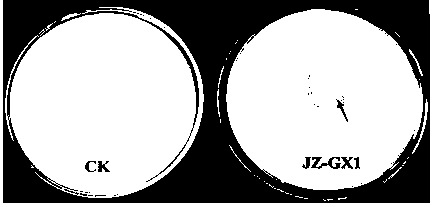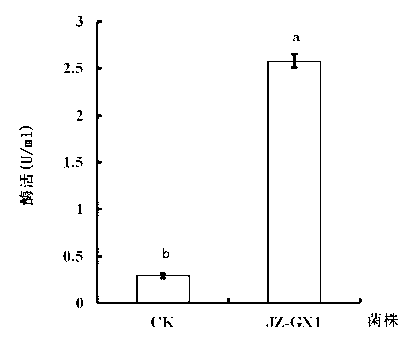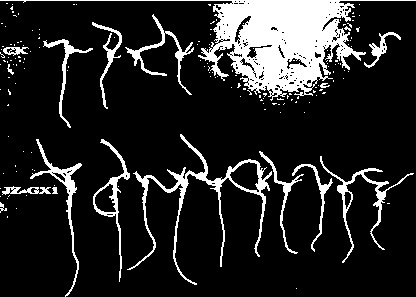High-efficiency phytate degradation bacterium Rahnella aquatils and application thereof in prompting plant growth
A technology of Lahenia water and phytate, which is applied in the field of microorganisms to achieve the effect of strong phytase activity, excellent strain resources, and growth promotion.
- Summary
- Abstract
- Description
- Claims
- Application Information
AI Technical Summary
Problems solved by technology
Method used
Image
Examples
Embodiment 1
[0024] Example 1 Determination of phytate degradation ability of Lahnella water JZ-GX1.
[0025] Phytate solid screening medium: Glucose 10g, Phytin 4.0g, MgCl 2 ·6H 2 O 5.0g, MgSO 4 ·7H 2 O 0.25g, KCl 0.2g, (NH 4 ) 2 SO 4 0.1g, 18.0g agar, 1000mL distilled water, adjust the pH to 7.0 with 0.1M NaOH solution.
[0026] Spot the activated JZ-GX1 strain and the control strain CK (organophosphate-solving bacteria YY-SX1, which was screened and preserved in the laboratory) on the phytate solid screening medium plate, and place the plate in a constant temperature incubator at 28°C were cultured for three days, with 3 replicates for each treatment. Then measure the colony diameter, penetrating ring and colony diameter of each bacterial strain, calculate the ratio, and name the ratio as HE.
[0027] The results are shown in Table 1 and figure 1 As shown, it can be preliminarily judged that the strain JZ-GX1 has better phytate degradation ability, which is significantly highe...
Embodiment 2
[0031] Example 2 Determination of phytase activity of Lahnella water JZ-GX1.
[0032]NB medium: beef extract 3g, peptone 10g, sodium chloride 5g, distilled water 1000mL, pH 7.2~7.4.
[0033] Phytate liquid fermentation medium: except that agar is not added, other components are the same as phytate solid screening medium.
[0034] Inoculate the activated JZ-GX1 strain and the control strain (YY-SX1, an inorganic phosphate-solving bacterium YY-SX1, which was screened and preserved in the laboratory) into medium NB medium, culture at 30°C and shake at 180r / min for 18-24 hours to make a seed solution, and take 0.5mL seed solution was inoculated into 100mL Erlenmeyer flasks containing 50mL phytate liquid fermentation medium, and each treatment was repeated three times. After 72 hours of shaking culture at 30°C and 180r / min, the fermentation broth was centrifuged at 4°C and 10000r / min for 10min. , Take the supernatant, that is, the crude enzyme solution, to measure the phytase acti...
Embodiment 3
[0036] Example 3 Determination test of auxin IAA produced by Lahnella water JZ-GX1.
[0037] TSB medium: tryptone 15g, soybean peptone 5g, NaCl 5g, distilled water 1L, pH7.2~7.4.
[0038] Add 50mL of TSB culture solution to each shake flask, and then add L-tryptophan to the concentration of 0, 100, 200, 300 and 500μg / mL (L-tryptophan mother solution: prepare with distilled water at 30-40℃ to 2 mg / mL, sterilized with a bacterial filter and stored for later use).
[0039] Inoculate the activated JZ-GX1 strain into NB medium, and culture at 30°C with shaking at 180r / min for 18-24 hours to make a seed solution. Take 0.5mL of the seed solution and inoculate them into 100mL Erlenmeyer flasks containing 50mL of TSB medium. Each treatment was repeated three times, cultured with shaking at 30°C and 180r / min, and the content of auxin IAA produced was measured after 72 hours. The fermentation broth was centrifuged at 5000r / min for 20min at 4°C to remove bacteria, and 1mL supernatant wa...
PUM
| Property | Measurement | Unit |
|---|---|---|
| Enzyme activity | aaaaa | aaaaa |
| Diameter | aaaaa | aaaaa |
| Growth rate | aaaaa | aaaaa |
Abstract
Description
Claims
Application Information
 Login to View More
Login to View More - R&D
- Intellectual Property
- Life Sciences
- Materials
- Tech Scout
- Unparalleled Data Quality
- Higher Quality Content
- 60% Fewer Hallucinations
Browse by: Latest US Patents, China's latest patents, Technical Efficacy Thesaurus, Application Domain, Technology Topic, Popular Technical Reports.
© 2025 PatSnap. All rights reserved.Legal|Privacy policy|Modern Slavery Act Transparency Statement|Sitemap|About US| Contact US: help@patsnap.com



